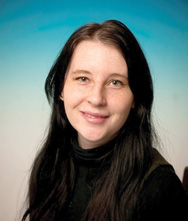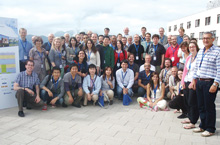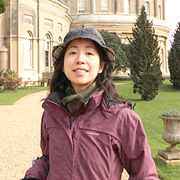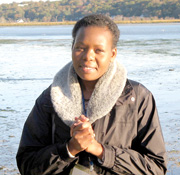| EDUCATION
CORNER
Learning to Become a Structural Biologist
by the 2011 RCSB PDB Poster Prize Awardees
The RCSB PDB awards a poster prize for the best student poster presentation at selected meetings. This Education Corner looks at the educational experiences that influenced the 2011 awardees.
For more information on the RCSB PDB Poster Prize, please see http://bit.ly/rCZxOZ.

BRIONY YORKE
Current Position: PhD student, University of Leeds
Past Education: Combined BSc and Masters, University of Leeds
RCSB PDB Poster Prize Awardee at American Crystallographic Association (ACA) for New Approaches to Time-Resolved Structural Studies of Macromolecules
Briony Yorke
I am a Wellcome Trust-funded graduate student at the University of Leeds working in Arwen Pearson's laboratory on time-resolved X-ray crystallography. I have a collaborative supervisorial team including Michael Webb, Emanuele Paci (University of Leeds) and Robin Owen (Diamond Light Source). I am trying to develop methods to enable time-resolved X-ray crystallography on irreversible systems using the microfocus beamline at Diamond Light Source (I24).
For my masters project at the University of Leeds, I worked on novel methods for ultra-fast time-resolved spectroscopy with Godfrey
Beddard. I was introduced to macromolecular crystallography by Dr. Pearson who asked me to analyze radiation damage in myoglobin crystals using spectroscopic data for a rotation project.
When looking at the plethora of structures in the PDB, it is often easy to forget how much work goes into each experiment leading up to the point of structure determination. In the case of X-ray crystallography, the difficulty of growing crystals in the first place is a common complaint, as is the process of obtaining high-resolution data. However, the work that goes into the software packages used to process the data is something that now, more than ever, goes unnoticed. The analysis and processing of X-ray crystallography data requires the use of many algorithms which are more often than not hidden behind a user friendly GUI (graphical user interface). As a young crystallographer I have found myself wanting to understand how crystallographic software is written and also how it is designed to ensure it is user-friendly and intuitive.
 The 2011 IUCr Crystallographic Computing School was held in Oviedo, Spain, with the theme Algorithms Development and Implementations. The school is run by the Computing Commission immediately before the triennial IUCr Congress and General Assembly. (Click to enlage)The 2011 IUCr Crystallographic Computing School provided me with an opportunity to learn about the processes involved in software design. It was also instructive in the utilization of currently available software and libraries for performing novel analysis on X-ray data. I found that many of the tools I will need for my thesis project already exist behind the scenes of current software and I learned the techniques necessary to utilize them. Tutorial sessions with groups of around 10 people provided an opportunity to ask questions relating to specific projects but also to observe how an experienced computational crystallographer would work out the answer. The 2011 IUCr Crystallographic Computing School was held in Oviedo, Spain, with the theme Algorithms Development and Implementations. The school is run by the Computing Commission immediately before the triennial IUCr Congress and General Assembly. (Click to enlage)The 2011 IUCr Crystallographic Computing School provided me with an opportunity to learn about the processes involved in software design. It was also instructive in the utilization of currently available software and libraries for performing novel analysis on X-ray data. I found that many of the tools I will need for my thesis project already exist behind the scenes of current software and I learned the techniques necessary to utilize them. Tutorial sessions with groups of around 10 people provided an opportunity to ask questions relating to specific projects but also to observe how an experienced computational crystallographer would work out the answer.

Tammy Cheng
Current Position: Postdoctoral Research Fellow at Cancer Research UK London Research Institute, UK
Past Education:
PhD in Biochemistry, University of Cambridge, UK; MSc in Chemistry, National Tsing-Hua University, Taiwan; BSc in Life Science, National Tsing-Hua University, Taiwan
RCSB PDB Poster Prize Awardee at the Annual International Conference for Intelligent Systems for Molecular Biology (ISMB) for Structural biology meets systems biology: Gauging the systemic impact of non-synonymous single nucleotide polymorphisms
Tammy Cheng
My enthusiasm in Structural Biology was first uncovered while an undergraduate student reading the classic textbook Introduction to Protein Structures by Carl Brandon and John Tooze. I found it fascinating that proteins implement their functions by delicately coordinating their 3D conformations, and the beautiful protein structures illustrated in the book left a deep impression on me. Since then I have been studying proteins ceaselessly, and that passion continues into my current post-doctoral research.
During my undergraduate study, I realized that my interest lay in studying proteins through a computational approach rather than wet-lab experiments. Before I finished my final undergraduate year, I decided to take a summer studentship at the Scripps Institute working on a protein structure viewer written in Python. As a result of this invaluable experience, I continued to explore computational algorithms for protein study. This led to a MSc Degree in Chemistry focusing on bioinformatics, and then a Ph.D. in Biochemistry specializing in computational biology.
With a deep interest rooted in protein structures, my Ph.D. research was concerned with the functional impact of proteins on a biological system. I studied non-synonymous single nucleotide polymorphisms (nsSNPs) and developed an algorithm, Bongo (www.bongo.cl.cam.ac.uk/Bongo2/Bongo.html), which analyzes the structural effect of nsSNPs on proteins. As an indirect approach to help estimate the possible phenotypic effect of nsSNPs, I was also involved in developing pyDock (life.bsc.es/servlet/pydock/), which predicts complex protein structures assuming rigid-body protein-protein interactions.
In addition to focusing on the behavior of proteins in isolation, I am now taking a further step to study the impact of nsSNPs at the cellular level. My current research project simulates the systemic effect of nsSNPs by considering both protein structure and pathway dynamics. Complemented by experimental data, my colleagues and I have shown that the impact of a nsSNP on a specific pathway can be effectively quantified as a combination of protein stability change and pathway perturbation. I am grateful to all the collaborators involved in this project, which won the 2011 RCSB PDB Poster Award at the ISMB conference.
I have always thought that it is exciting to facilitate our understanding
of the human genome by utilizing the knowledge of proteins, and this continues to motivate the direction of my research. I would like to take this opportunity to say 'thank you' to everyone who has ever worked on the PDB, which has always been an essential part of my research. I have no doubt that PDB will continue to play an important role in a wide range of research in the future.

Serah Kimani
Current Position: PhD student in Molecular and Cell Biology, University of Cape Town, South Africa
Past Education:
MSc in Structural Biology, University of Cape Town and the University of the Western Cape; BSc in Biomedical Sciences and Technology, Egerton University, Kenya
RCSB PDB Poster Prize Awardee at the Congress and General Assembly of the International Union of Crystallography for Unexpected reactions resulting from mutating catalytic residues in an amidase reveal the role of the catalytic unit. Serah also received the award at the Asian Crystallographic Association Meeting in 2007, and at ACA in 2010.
Serah Kimani
I was born and raised in Gacharage, a small village in central Kenya. I did a BSc (Hons) in Biomedical Sciences and Technology at Egerton University (Kenya); a course that not only turned out to be over 98% theory due to lack of resources in our public universities, but also lacked a few key aspects of biochemistry like protein biochemistry. It is therefore not surprising that when I completed my degree I was completely ignorant of macromolecular structures. I saw a pamphlet advertising a new master's course in structural biology at the University of Cape Town (UCT, South Africa) and it promised a bursary, making it quite attractive even though for me it was clearly an adventure into a world unknown to me.
When I started at UCT, the learning curve was obviously quite steep given my background. I had to begin with the very basics of mastering the structures and properties of the 20 amino acids as well as learning how to use a computer, since I had never owned or worked at one before except to use email. Google and the internet in general became a friendly companion that slowly but surely helped to shorten the gap. I came face-to-face with a lot of challenging mathematics, physics and computer programming that I would never have thought were behind the structure-determining processes. But despite the difficulties, every unveiled detail was exciting, and I was amazed by the cool insights that one could obtain from structures. The idea of 'structure-based drug design,' for example, held great interest and appeal. In addition to traditional classroom lectures, web-based course materials from other universities (especially Birkbeck College, London) have formed a major part of my understanding of structural biology methods. I have also had the privilege of learning from experts and specialists in the field, who were flown into South Africa to give short courses and conduct workshops on various techniques, as well as share their work during the early days of the structural biology program at UCT.
Regular email correspondence with distinguished crystallographers and software developers has been a great resource in my research work. For instance, in my MSc dissertation project I had a difficult task of solving the crystal structure of a bacterial amidase6,7 that had roughly 20% sequence identity with a few homologous structures in the PDB using molecular replacement phasing method. With extensive reading and expert guidance through endless email communications with scientists like Prof. Randy Reed (Cambridge, UK) and Prof. Thomas Terwilliger (Los Alamos National Laboratory, USA), among others, I was able to overcome problems related
to phasing and structure refinement, and to solve one of the first crystal structures of an aliphatic amidase from the nitrilase superfamily of enzymes.
The CCP4 bulletin board (ccp4bb) has also been quite instrumental in my work. In my current PhD project, which is concerned with understanding the role of the catalytic residues in amidases, I have frequently run into the problem of protein misfolding and instability on mutation of some of the active site residues. The crystallographers on ccp4bb have willingly provided many handy tips on how to overcome this and numerous other problems. My attendance at both local and international conferences and workshops has been a means of keeping in touch with the current developments in structural biology, as well as sharing my work, while consultations with my colleagues have enhanced my research and continually shaped me to be a better scientist.
It is unfortunate that protein structures remain unknown and thus unutilized in most parts of Africa. It is my hope that after my training, I will go back to Kenya and contribute towards raising awareness of structures. An introduction of a protein biochemistry module in undergraduate biological courses at universities would be a great start.
|


 The 2011 IUCr Crystallographic Computing School was held in Oviedo, Spain, with the theme Algorithms Development and Implementations. The school is run by the Computing Commission immediately before the triennial IUCr Congress and General Assembly. (Click to enlage)The 2011 IUCr Crystallographic Computing School provided me with an opportunity to learn about the processes involved in software design. It was also instructive in the utilization of currently available software and libraries for performing novel analysis on X-ray data. I found that many of the tools I will need for my thesis project already exist behind the scenes of current software and I learned the techniques necessary to utilize them. Tutorial sessions with groups of around 10 people provided an opportunity to ask questions relating to specific projects but also to observe how an experienced computational crystallographer would work out the answer.
The 2011 IUCr Crystallographic Computing School was held in Oviedo, Spain, with the theme Algorithms Development and Implementations. The school is run by the Computing Commission immediately before the triennial IUCr Congress and General Assembly. (Click to enlage)The 2011 IUCr Crystallographic Computing School provided me with an opportunity to learn about the processes involved in software design. It was also instructive in the utilization of currently available software and libraries for performing novel analysis on X-ray data. I found that many of the tools I will need for my thesis project already exist behind the scenes of current software and I learned the techniques necessary to utilize them. Tutorial sessions with groups of around 10 people provided an opportunity to ask questions relating to specific projects but also to observe how an experienced computational crystallographer would work out the answer.

